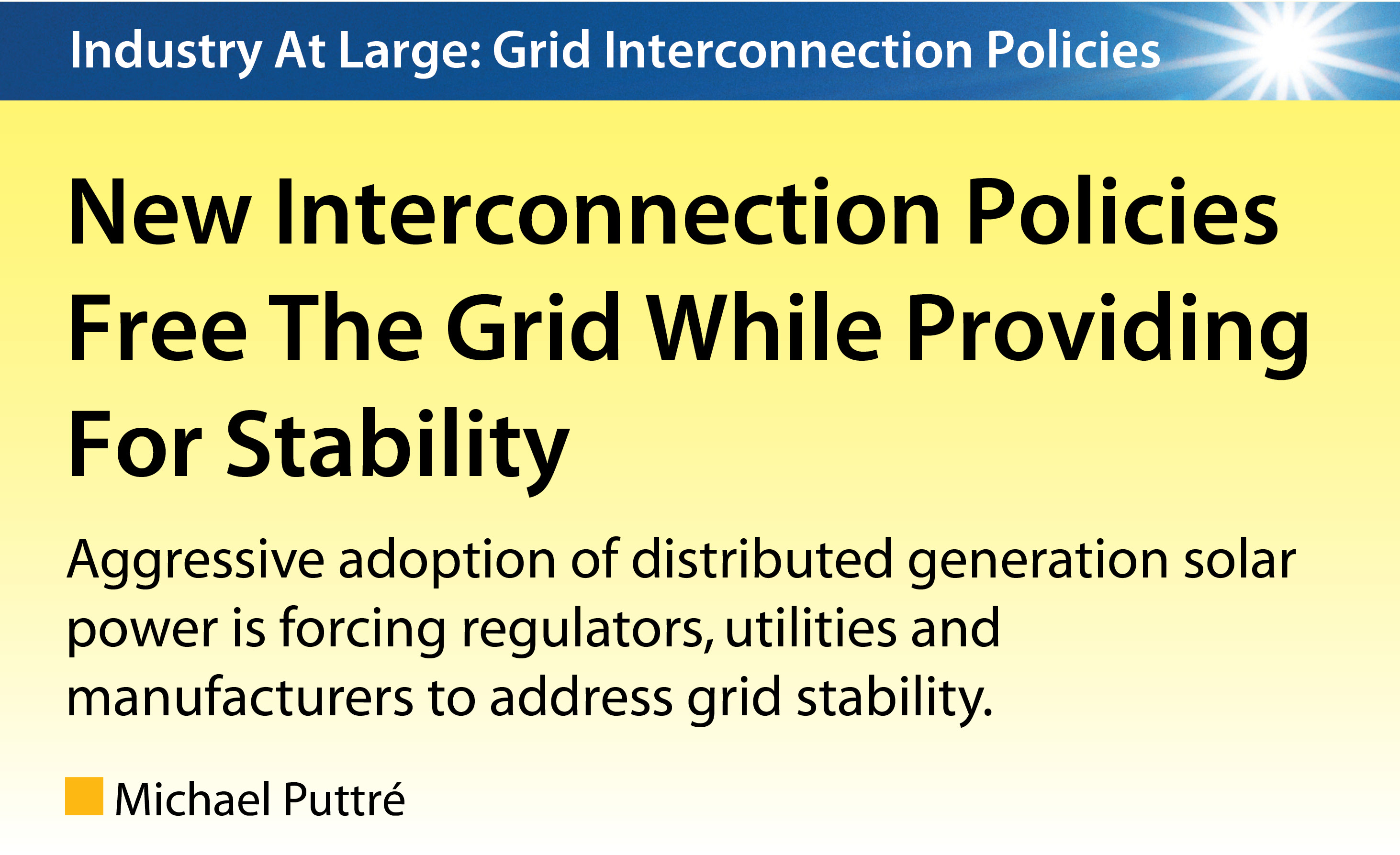

301 Moved Permanently
Grid interconnection is widely regarded as the most significant barrier to the installation of distributed generation solar power. Thus, the solar sector typically welcomes efforts by regulators to relax grid interconnection rules, particularly with regard to the yardsticks utilities use to trigger processes that may hold up interconnection of distributed generation capacity.
In March, the Massachusetts Technical Standards Review Group (TSRG) issued a recommendation that the Massachusetts Department of Public Utilities (DPU) use 100% of minimum load as the penetration screen within the supplemental review process rather than the current 67% screen. Thus, if it is determined that the aggregate generating capacity is less than 100% of minimum load - daytime minimum load for photovoltaic systems - a generator may be allowed to interconnect without detailed study. If the generating capacity exceeds 100% of minimum load, the generator will likely require detailed study.
The Interstate Renewable Energy Council (IREC) supports the TSRG recommendation, saying the revised threshold should allow utilities to process more applications in less time through an expedited review process while still ensuring system safety and reliability. Although this update to the interconnection tariff may require further public comment, IREC anticipates that the DPU will ultimately accept the TSRG’s recommendation and that the Massachusetts utilities will incorporate the 100% screen into their individual interconnection tariffs in the near future.
IREC has long championed the adoption of streamlined interconnection application procedures as an important means of eliminating one of the principal bottlenecks to the adoption of renewable energy, and distributed generation solar power in particular.

“There is little to no reason why there should be any debate between 67 percent and 100 percent minimum load screens,” says Sky Stanfield, an associate in the law firm Keyes, Fox & Wiedman LLP, who represents IREC.
According to IREC, there were 65,000 grid-connected PV installations of all sizes in the U.S. in 2011. In 2012, the number of connections jumped to 95,000, meaning that utilities had to approve 30,000 new interconnection applications over the course of a single year. This figure does not count applications that were considered and rejected.
Residential-type installations are generally put on a “fast track” evaluation process; nevertheless, the sheer volume is a tremendous strain on the small generator interconnection procedures the U.S. Federal Energy Regulatory Commission (FERC) enacted in 2005, when there were a mere 7,000 PV grid connections in the U.S.
IREC and the Vote Solar Initiative report in the 2013 edition of their “Freeing the Grid” annual report on net metering and interconnection procedures that many states are making headway in adopting grid policies conducive to the deployment of distributed solar power. The organizations say more than half of U.S. states have “A” or “B” grades, reflecting best practices. IREC says use of the 100% of minimum load threshold constitutes one such best practice.
In November, FERC issued a modification to its Small Generator Interconnection Agreements and Procedures rule, enabling certain appropriately located, inverter-based generators below 2 MW to qualify for fast-track approval procedures. Previous rules required such small generators to be between 2 MW and 5 MW to quality for fast-track consideration.
The FERC decision will not directly affect residential photovoltaic installations because the vast majority of residential connections are under the jurisdiction of state public utility commissions. Nevertheless, solar sector observers expect states to take notice of the decision and use it as a model for their own interconnect policies.
“FERC rules provide a model for states to follow,” Stanfield says. “Historically, when the feds act, the states listen.”
Follow the leader
Utilities tend to err on the side of caution in their roles of guardians of the grid infrastructure, and concerns are not unfounded. The problem is not adding photovoltaics to the grid per se, but adding any source of electricity that can be intermittent or variable. The more variable sources that are added into the energy mix on the grid, the more that grid has to compensate when the sources are no longer available.
Thus, it is possible that an abundance of renewable energy on a grid can destabilize it in areas with aggressive solarization programs. Another issue is that grid loads change as well, and peak late in the afternoon when the solar generation is starting to decline. So, the problem is that generation and loads are not well matched. This problem can lead to grid instability, which forces utilities to maintain traditional generation sources - an approach that is costly to all of the utility’s customers.
“The industry, utilities and inverter companies must move away from cumbersome and time-consuming grid studies into an era where the grid adjustments can be made autonomously, quickly, safely and reliably,” says Alan Beale, general manager of SolarMax USA. “In most cases, the interconnection process has been straightforward. In some cases, detailed studies have been required to analyze the effect of variable generation. For inverter manufacturers, the process included clearly defined operating parameters and specifications from the data sheet, and compliance with well-established standards like UL 1741 and IEEE 1547. As grid requirements for ‘smart inverters’ come into play from utilities, all inverter and storage systems must operate and comply with updated standards.”
In 2012, Germany rectified the problem by implementing a new low-voltage interconnection standard. Additionally, Germany instituted a field retrofitting effort that involved changing the pre-programmed over-frequency trip settings in PV inverters. About 315,000 PV systems sized 10 kW or larger are scheduled to have their inverters either retrofitted or replaced within four years. German solar officials contend that the retrofitted inverters will be less sensitive for increased ride-through and staged in their timing to minimize their switching impact.
Last year, the San Diego-based Western Electric Industry Leaders (WEIL) group urged regulators to require the installation of “smart inverters” on all new solar generators in the region to ensure their smooth integration into the electric grid. The group, comprising utility companies, government agencies, and electricity producers and power providers throughout the western U.S., says the technology is vital for enabling solar installations to provide the necessary voltage support due to the intermittent nature of their function as electricity generators, which can cause power quality and reliability problems.
Specifically citing the example of Germany, WEIL says quick action would protect the grid from power fluctuations caused by the integration of increasing amounts of variable generation solar capacity. The group says one way to mitigate the voltage swings caused by PV systems and manage the voltage within the allowed operating range is to use inverters similar to those deployed in Europe with features such as dynamic reactive power control.
Inverter manufacturers say there are indeed many things they can do to facilitate the adoption of variable generation sources on the grid, such as offsetting loads and functioning as an energy-storage device:
- Offsetting loads using renewable energy locally - instead of selling solar-generated electricity back to the grid. An inverter can use that electricity to essentially serve as a microgrid at the home or business, reducing or even eliminating the demands on the grid at that one location. Basically, it can take premises off-grid, saving the system owner money through self-consumption, rather than dumping the surplus back onto the grid and increasing the risk of instability.
- Storing energy instead of using it or selling it back. If the user has an excess of renewably generated electricity even after consuming what it can locally, a bi-directional inverter with charging capability can redirect any surplus into a battery bank for later use, maybe during peak times, in the evening or possibly during an outage. This type of inverter/charger system adds value as a backup power solution during emergencies.
Point of contact
According to Brian Faley, director of technology at Outback Power, inverters are the logical point of contact for managing grid stability issues.
“The inverter touches every aspect of the electrical infrastructure - from point of entry for utility power to the loads themselves, through the premises’ wiring and electrical panel,” Faley says. “Plus, most inverters have communications inputs and networking capabilities to interface with a variety of control and monitoring devices including PCs, programmers, dedicated displays and others.”
“Smart inverters will need advanced features,” says SolarMax’s Beale. He identifies the key attributes as, first and foremost, the ability to vary the output power, including throttling and injection of reactive power. Second, the inverters will need to make automatic adjustments to changing grid conditions - autonomous dynamic power output. Third, and perhaps most important, the inverters must be able to communicate two ways, not only reporting what they are doing in real time, but supporting external commands from a power controller - or maybe from a smart meter or a home energy portal.
SunSpec Alliance, a nonprofit industry and academic group seeking to develop standards for solar electric generation and assessment, is working on providing the necessary controls to allow implantation of standardized smart grid protocols. (See “Improved Performance Assessment Leads To Greater PV Plant Bankability,” p. 28.) Such efforts extend to both autonomous functions in phase one and the more sophisticated layers of encryption and security and control that phases two and three provide.
“As the utilities implement more complicated distributed control architectures, the inverters can provide localized grid parameters, which can be used by the grid operators to stabilize or control on a much tighter basis,” says Outback’s Faley.
Inverter manufacturers say they have a role to play by producing products that are compliant with regulatory standards, such as UL 1741B and IEEE 1547, which govern inverter behavior to an agreed-upon standard. The whole purpose of standards is to eliminate the need for reviews by providing consistent inverter operation over the entire market. The Smart Inverter Working Group, of the California Public Utilities Commission, and SunSpec are working to come up with ways of testing and simulation for operating inverters deployed in smart grids in an intelligent and reproducible way.
As higher levels of PV penetration are achieved, more reactive power is needed to reduce the burden on the grid. Current interconnection standards, such as UL 1547, prohibit inverters from providing reactive power, but the new smart grid rules could provide a way for inverters to stabilize the grid by producing reactive power at the point of common coupling - the place where the inverter attaches to the utility.
“Manufacturers must push to develop products that comply, and not hinder the implementation of these standards,” Beale says. “The industry must continue to develop product test procedures and even product commissioning procedures that show compliance and are clear and concise.”
Ideally, Beale says, the inverters should be able to “test themselves,” automatically adapting to grid conditions, and reporting in real time that the systems are working. With two-way communication to system controllers, inverters will be integrated closely with storage solutions that allow power to be generated in peak irradiance cycles, and shift that power to loads in later time periods.
“Inverters will maintain their position as the interface point between safe, efficient generation of renewable power and grid stability,” Beale says. “They will continue to evolve in areas of efficiency, safety, accessibility and control.” R
Industry At Large: Grid Interconnection Policies
New Interconnection Policies Free The Grid While Providing For Stability
By Michael Puttré
Aggressive adoption of distributed generation solar power is forcing regulators, utilities and manufacturers to address grid stability.


si body si body i si body bi si body b
si depbio
- si bullets
si sh
si subhead
pullquote
si first graph
si sh no rule
si last graph